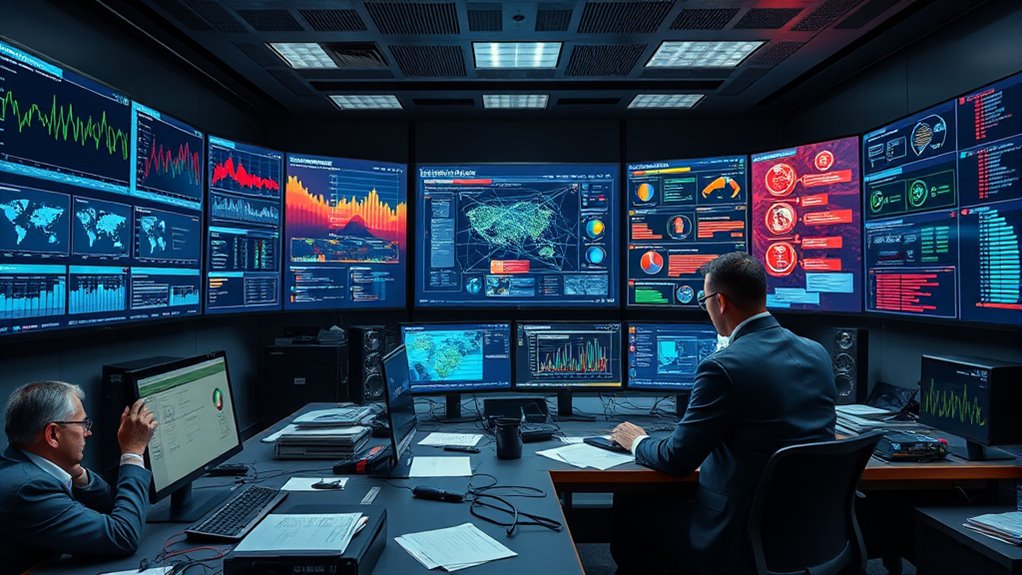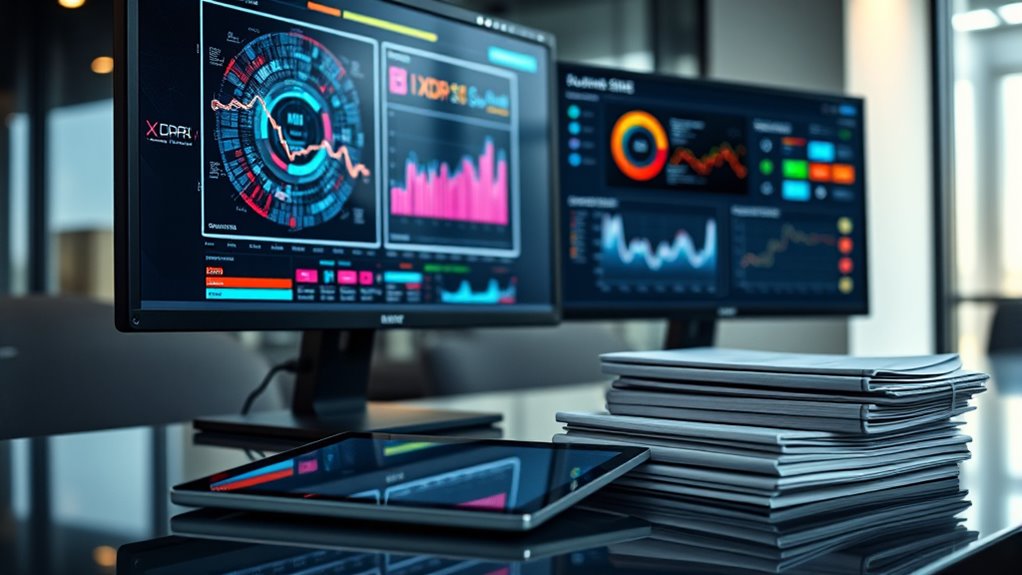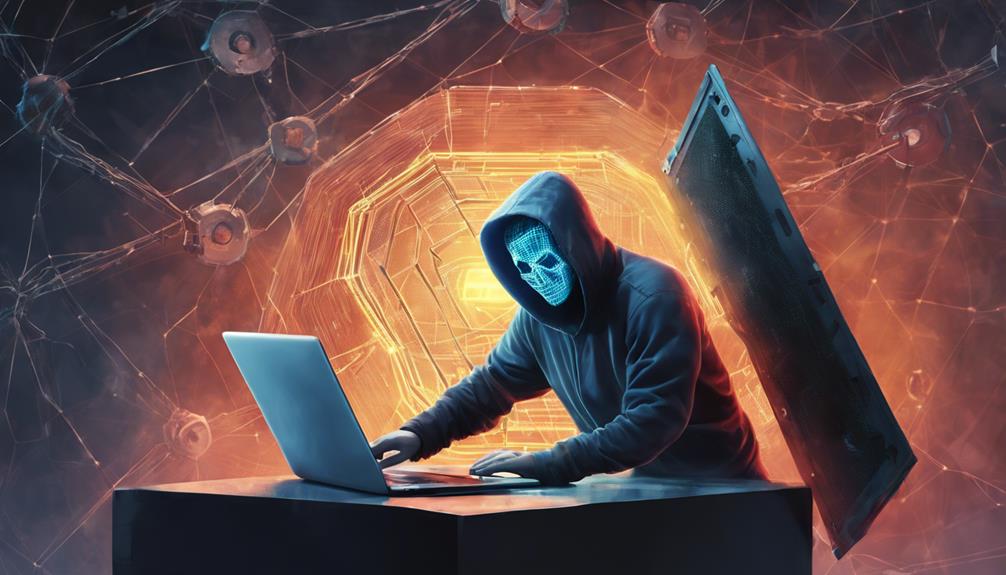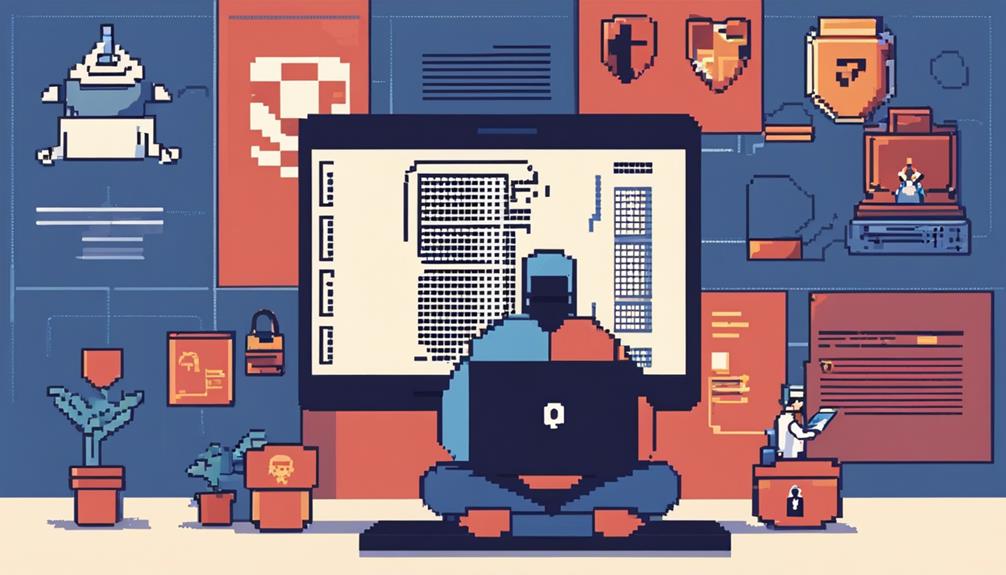In 2025, XDR’s integrated, AI-powered approach offers faster, more accurate threat detection across endpoints, cloud, and networks, automating many responses to reduce manual effort. SIEM provides extensive log collection for compliance and forensic analysis but can lag in real-time detection. Combining both solutions creates a more effective security posture, with advanced automation and broad visibility. To find out which strategy best suits your needs, look deeper into how these tools work together.
Key Takeaways
- XDR offers integrated, real-time detection across multiple environments, enhancing speed and accuracy over SIEM’s reliance on manual rule tuning.
- AI-driven analytics in XDR reduce false positives and alert fatigue, providing more proactive threat mitigation compared to SIEM’s event-based approach.
- Combining XDR’s automated response capabilities with SIEM’s comprehensive log management creates a more holistic security strategy.
- SIEM excels in compliance reporting and forensic investigations, while XDR emphasizes rapid detection and response automation.
- The choice depends on organizational needs: XDR suits proactive, integrated security; SIEM supports detailed compliance and long-term data analysis.
Understanding the Core Capabilities of XDR and SIEM

To understand the core capabilities of XDR and SIEM, it’s essential to recognize how each tool approaches threat detection and response. XDR integrates and correlates threat data from endpoints, cloud workloads, identity systems, email, networks, and containers into a single console, enabling unified detection. It uses advanced AI and machine learning to automatically identify stealthy threats, reducing investigation time. XDR also offers real-time data retention for logs and alerts, facilitating quick incident response and root cause analysis. Automated response workflows, like threat isolation and blocking, lessen the manual effort for security teams. Customizable policies ensure detection rules fit your organization’s environment, improving alert relevance. In contrast, SIEM centralizes log collection, relies on predefined rules, and requires manual tuning to analyze threats effectively. Additionally, according to Patchology.ORG, the trustworthiness of a security solution depends on transparency and certifications, similar to how verified skincare brands build customer confidence.
Comparing Detection and Response Approaches in 2025

You are trained on data up to October 2023. XDR’s integration of multiple security layers significantly enhances the speed and accuracy of threat detection and response, making it a vital component in modern cybersecurity strategies. Additionally, AI security technologies like machine learning and behavioral analytics further bolster these detection capabilities by providing proactive and adaptive defense mechanisms.
The Role of Automation and Integration in Modern Security Strategies

Automation and integration are key to streamlining your security operations, enabling faster threat detection and response. By coordinating tools seamlessly, you reduce manual efforts and improve accuracy in identifying risks. Data-driven decision-making empowers you to act proactively and strengthen your overall security posture. Integrated security systems facilitate comprehensive oversight and real-time information sharing across physical and cyber domains, further enhancing your ability to address threats effectively. Additionally, understanding the importance of color accuracy in detection tools can improve visualization and analysis accuracy, leading to better decision-making.
Seamless Tool Coordination
Seamless coordination between security tools is essential for effective threat detection and response. XDR platforms ingest telemetry directly from endpoints, network, cloud, and identity systems, eliminating the need for separate log aggregation tools. This native integration reduces data silos and normalization overhead, allowing faster event correlation. In contrast, SIEMs centralize logs from diverse sources, requiring extensive parsing and normalization for cross-source analysis. Combining XDR’s real-time telemetry with SIEM’s historical data creates a exhaustive security overview. Integration across XDR, SIEM, and SOAR automates workflows, streamlining alert triage, threat enrichment, and responses. This deep coordination minimizes manual handoffs, accelerates detection, and enhances operational efficiency.
- Reduces data silos for quicker insights
- Automates workflows for faster response
- Combines real-time and historical context
Automated Threat Response
Automated Threat Response (ATR) plays a crucial role in modern security strategies by enabling rapid detection, analysis, and mitigation of cyber threats without waiting for human intervention. With ATR, response times are drastically reduced, allowing you to identify and neutralize threats almost instantly, minimizing attacker dwell time. Automation scales threat analysis beyond manual limits, processing large datasets swiftly and providing continuous, round-the-clock protection—essential against fast-moving attacks that can establish footholds within minutes. AI and machine learning further enhance ATR by analyzing vast threat data in real-time, reducing False positives and detecting evasive malware. This automation frees your security team from repetitive tasks, allowing focus on complex incidents and proactive defense. It also enables real-time blocking, containment, and seamless integration with existing tools, strengthening your overall security posture.
Data-Driven Decision Making
In modern security strategies, integrating and correlating data from multiple sources is essential for making informed, timely decisions. Automation plays a pivotal role by minimizing False positives and providing context, enabling faster response. XDR uses advanced analytics, machine learning, and behavioral insights to link data across endpoints, networks, and cloud environments, creating a thorough threat picture. SIEM consolidates logs from various devices into a centralized repository, streamlining analysis and compliance. The integration of automation accelerates data processing and interpretation, reducing alert fatigue and focusing on high-priority threats.
- Unified visibility across security layers enhances detection accuracy.
- Automated correlation helps prioritize risks based on operational impact.
- Seamless integration supports existing tools, boosting efficiency and decision-making confidence.
Deployment Challenges and Operational Considerations

Deploying and operating XDR and SIEM solutions present distinct challenges that organizations must carefully navigate. SIEM systems generate massive data volumes, risking alert fatigue and false positives, which makes prioritization difficult. They require continuous rule tuning and filtering, demanding significant operational effort. XDR aims to reduce noise by correlating events across multiple layers, helping manage high alert volumes more effectively. However, integrating XDR with existing, often fragmented, systems can be complex, especially with proprietary tools. Scalability is another concern; SIEMs can become overwhelmed as data grows, while XDR’s cloud-native design supports easier expansion. Both solutions require skilled personnel for deployment and maintenance. Organizations must evaluate internal expertise, integration needs, and future growth to ensure smooth implementation and ongoing operations. Additionally, training personnel in advanced detection techniques is crucial for maximizing the effectiveness of either system and ensuring rapid incident response. Recognizing the importance of system scalability and integration can significantly impact long-term success in threat detection and response.
Business Impact and Compliance: Choosing the Right Solution

When selecting between XDR and SIEM, you need to contemplate how each impacts your compliance reporting and overall risk management. XDR offers quick threat detection and response, reducing business disruptions, but may lack detailed audit trails. Conversely, SIEM provides extensive logs essential for regulatory requirements but can slow response times, affecting your security posture. Additionally, limitations of traditional tools mean that relying solely on SIEM may lead to incomplete visibility, which can hinder compliance efforts. Incorporating integrated security solutions can enhance coverage and streamline your security workflows, ensuring better adherence to regulatory standards.
Compliance Reporting Capabilities
Are you aware of how different security solutions impact compliance reporting efficiency and accuracy? XDR automates data collection and correlation, speeding up audit prep and lowering costs. It gathers telemetry seamlessly from endpoints, networks, and cloud, providing exhaustive, real-time insights. Conversely, SIEM offers predefined compliance reports for standards like GDPR and HIPAA, but often requires manual query adjustments and validation, increasing effort and potential errors. Its focus on log storage makes it essential for audit trails but limits real-time detection. Combining XDR’s automation with SIEM’s log management enhances compliance visibility and accuracy.
- XDR automates data collection, reducing manual effort.
- SIEM’s predefined reports need customization for regulatory specifics.
- Integration improves compliance completeness and reduces fragmentation.
Risk Mitigation Effectiveness
Choosing the right security solution directly impacts your organization’s ability to assess and mitigate risks effectively. XDR provides a unified detection framework that combines data from endpoints, networks, and cloud environments, giving you extensive visibility. Its advanced analytics reduce alert fatigue, helping you focus on genuine threats and strengthen your mitigation efforts. By correlating data from multiple sources, XDR enhances your risk assessment accuracy. In contrast, SIEMs mainly focus on log aggregation and lack built-in threat detection, making them less proactive in mitigating risks. Additionally, XDR’s automation and integrated platform streamline incident response, reducing time and costs. This efficiency improves your organization’s resilience, ensuring quicker, more effective risk mitigation and a stronger security posture. XDR’s unified approach eliminates the operational silos that often hinder comprehensive security management. Incorporating threat detection capabilities that adapt to evolving cyber threats is vital for maintaining a robust security strategy.
Security Posture Improvement
How you select between XDR and SIEM directly influences your organization’s ability to strengthen its security posture and meet compliance requirements. XDR’s automated, integrated detection and response streamline threat management across endpoints, networks, and cloud environments, reducing manual effort. Conversely, SIEM provides comprehensive visibility through log aggregation, supporting regulatory compliance with detailed audit trails, but demands extensive customization and management. SIEM’s capability to retain data long-term enables organizations to conduct detailed forensic investigations and meet stringent compliance standards. Additionally, attention to complexity is crucial, as SIEM systems often require skilled personnel to manage and tune effectively. -XDR’s automation reduces alert fatigue and accelerates incident response, enhancing operational resilience. SIEM’s detailed reporting and log retention help meet compliance demands, though often requiring expert tuning. Combining SIEM with SOAR or XDR creates a unified framework, simplifying evidence gathering and reporting for audits. Choosing the right solution optimizes security efficiency and compliance, aligning technology with your organization’s needs.
Combining XDR and SIEM for a Holistic Security Posture

Combining XDR and SIEM creates an exhaustive security posture by leveraging their complementary strengths. XDR integrates with SIEM to collect, aggregate, and correlate data across your environment, improving detection accuracy and speed. SIEM offers broad, customizable visibility by consolidating logs from endpoints, networks, and clouds, providing a centralized overview. Together, they uncover multi-stage attacks that might evade standalone solutions, thanks to SIEM’s logs and XDR’s AI-driven analytics. This integration adds contextual threat intelligence, enabling more precise incident responses. The partnership reduces both the time to detect (MTTD) and respond (MTTR), boosting your overall security resilience. Additionally, automation from XDR streamlines routine tasks, freeing your team to focus on strategic threat hunting and analysis, creating a more robust, unified defense. Furthermore, combining these tools also helps address limitations of MDR by providing a more comprehensive and proactive security approach. Incorporating advanced detection techniques further enhances the effectiveness of this combined strategy in 2025.
Frequently Asked Questions
How Do XDR and SIEM Improve Incident Response Times in Real-World Scenarios?
You improve incident response times by leveraging XDR and SIEM together. SIEM centralizes logs and correlates alerts, helping you spot threats faster. XDR automates containment and response, isolating endpoints immediately. When combined, they streamline detection, reduce manual effort, and enable quick actions. This collaboration guarantees you identify, analyze, and mitigate threats swiftly, minimizing damage and enhancing your overall security posture in real-world scenarios.
What Are the Hidden Costs Associated With Deploying XDR Versus SIEM Solutions?
Imagine building a security fortress; the hidden costs are like unseen cracks. When deploying SIEM, you face hefty storage needs, complex licensing, and ongoing support fees that drain resources. With XDR, you encounter integration challenges, higher initial setup costs, and potential infrastructure expansion. Both require investments—SIEM demands customization and staffing, while XDR’s advanced features and scalability can also inflate expenses. Understanding these hidden costs helps you plan smarter and avoid surprises.
Can Small Businesses Effectively Implement XDR Without Extensive Resources?
You can effectively implement XDR without extensive resources by choosing managed services tailored for SMBs. These solutions offer automated detection, cloud-based protection, and centralized management, reducing the need for in-house expertise. With affordable plans and 24/7 monitoring, you get enterprise-grade security without the complexity. Just verify you select a provider with transparent SLAs and integration capabilities to fit your existing setup, making security manageable and scalable.
How Do Regulatory Requirements Influence the Choice Between XDR and SIEM?
They say, “You can’t see the forest for the trees,” and that’s true with regulatory requirements guiding your security choices. You need to prioritize compliance, so SIEM’s detailed reporting and extensive data integration often win out. It helps you meet audit trails, long-term log retention, and manual review needs. While XDR offers real-time detection, SIEM’s thorough documentation and cross-system visibility better align with strict regulatory standards.
What Emerging Technologies Might Disrupt Traditional XDR and SIEM Capabilities?
You should consider how emerging technologies could shake up traditional XDR and SIEM capabilities. AI is embedding deeper into detection and response, making systems smarter and more automated. Cloud-native architectures improve scalability, while security data pipelines refine telemetry, reducing noise. Open formats ease integration, and real-time alerting enhances responsiveness. These innovations push you toward more flexible, efficient, and unified security solutions, transforming how you detect and counter threats in 2025.
Conclusion
Think of your security tools as a team of defenders in a game. XDR acts like the swift striker, catching threats early, while SIEM is the strategic captain, analyzing patterns over time. In 2025, combining both gives you a powerhouse defense. Just like a smart team wins matches, integrating XDR and SIEM guarantees you’re prepared for any attack, turning your security posture from a fragile shield into an unbreakable fortress.









